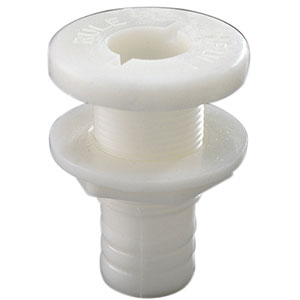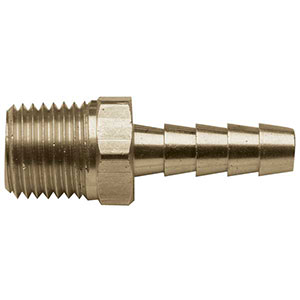When selecting a plumbing fitting, consider how the fitting will be used and where it will be installed. Fittings exposed to seawater (such as thru-hull fittings and valves) must be strong and resistant to galvanic corrosion. Plastic plumbing fittings should never be used in below-the-waterline applications.

Nylon thru-hull fittings like this are culprits in more than a few sinkings, when used as cockpit drains that ended up underwater and were cracked due to age and UV damage. Nylon is most definitely not for below-waterline use.
What is galvanic corrosion?
When immersed in an electrolyte (e.g., saltwater) dissimilar metals in contact with each other can produce a galvanic reaction wherein one of the metals is anodic to the other. When this occurs the anodic metal will dissolve or “sacrifice itself”. A typical example of this is where a bronze propeller is installed on a stainless steel shaft. To prevent the propeller from reacting with the shaft and disintegrating, sacrificial anodes must be installed—either on the shaft, the propeller or both. Sacrificial anodes are offered in zinc, magnesium and aluminum—with the correct choice dependent on whether the boat is located in salt-, fresh- or brackish water. Other examples of where sacrificial anodes are normally required include inboard engines, water heaters, keel coolers, rudders and trim tabs. Bronze thru hulls that are not in contact with dissimilar metals theoretically do not require a sacrificial anode—however in practice they are often bonded (connected with a wire) to a sacrificial anode located on the outer surface of the hull.
Don't mix brass with bronze!
Due to their potential for galvanic corrosion, bronze and brass plumbing fittings should not be mixed. You can generally tell the alloys apart by examining the fittings. Brass and bronze have a slightly different color and sheen. Compared to the darker color of bronze, brass has a lighter finish with a bright sheen, much like gold. The smooth machined surfaces of bronze plumbing parts, such as the face of a mushroom thru-hull fitting will contrast with the rough, sand-like texture of surfaces that are not machined. That’s because bronze fittings are sand cast, and then machined.
When examining thru-hull fittings and associated components, be on the lookout for signs of galvanic corrosion, such as components that have taken on a reddish cast. Once when one of the co-authors of this article was examining a thru-hull assembly on his Cal 2-29 sloop, he was surprised by a fitting that turned out to be made of brass. Merely poking it with his finger caused it to spout a serious leak. Closing the thru-hull valve enabled the fitting to be safely replaced with one made of bronze.
Marelon
Marelon is a high strength, polymer composite, developed as a solution to electrolysis and corrosion problems associated with bronze and brass plumbing fittings. Marelon will not corrode—that is, no electrolysis. Marelon is UL/ABYC approved and ISO certified. It can be used above or below the waterline.
Acetyl Plastic (nylon)
This is an inexpensive alternative to brass or bronze that is recommended only for above-the-waterline use.
What should you do?
For below-the-waterline plumbing, select components made of bronze or Marelon. If you prefer bronze, follow sound marine practice; use bronze fittings for thru-hull fittings, seacocks, strainer bodies and valves. If one of the pipes must be turned through an angle, use a 90° or 45° bronze street ell. Once the bronze fittings are in place and aligned, thread a bronze hose barb into each, and join them with sturdy hoses and stainless steel clamps.

This shiny brass pipe-to-hose fitting is fine for a fuel line, but brass should never be used in raw-water plumbing that is at risk of galvanic corrosion
More Advice
Here is an excellent bit of advice reprinted from an article by Steve D’Antonio that appeared in the September, 2008 edition of Professional Boatbuilder magazine:
Silicon bronze and leaded red brass make good seacocks. Leaded red brass, sometimes referred to as “85-5-5-5” due to its constituent alloys of 85% copper, 5% zinc, 5% lead and 5% silicon, should not be confused with ordinary brass, whose zinc content is much higher. High-zinc-content alloys like ordinary brass or Tobin bronze must never be used for seacocks or any raw below-the-waterline (BTW) plumbing. This prohibition includes even the smallest seacock or raw-water strainer drain plugs, which are often inadvertently replaced with brass rather than bronze hardware.